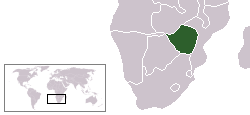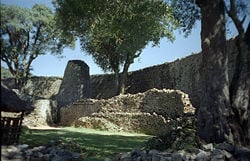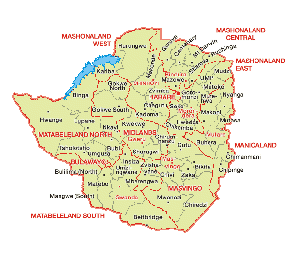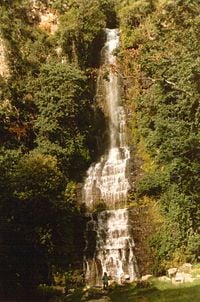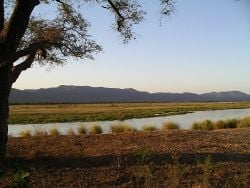Zimbabwe
| Republic of Zimbabwe | ||||||
|---|---|---|---|---|---|---|
|
||||||
| Motto: "Unity, Freedom, Work" | ||||||
| Anthem: Simudzai Mureza WeZimbabwe (Shona) Kalibusiswe Ilizwe leZimbabwe (Sindebele) "Blessed be the land of Zimbabwe" |
||||||
| Location of Zimbabwe
|
||||||
| Capital (and largest city) | Harare 17°50′S 31°3′E | |||||
| Official languages | English, Shona, Ndebele | |||||
| Demonym | Zimbabwean | |||||
| Government | ||||||
| - | President | Emmerson Mnangagwa | ||||
| - | Vice President | Phelekezela Mphoko | ||||
| Independence | from the United Kingdom | |||||
| - | Proclaimed | 11 November 1965 | ||||
| - | Recognized | 18 April 1980 | ||||
| Area | ||||||
| - | Total | 390,757 km² (60th) 150,871 sq mi |
||||
| - | Water (%) | 1 | ||||
| Population | ||||||
| - | 2016 estimate | 16,150,362 (73rd) | ||||
| - | 2012 census | 12,973,808[1] | ||||
| - | Density | 26/km² (170th) 57/sq mi |
||||
| GDP (PPP) | 2017 estimate | |||||
| - | Total | $33.872 billion[2] | ||||
| - | Per capita | $2,276[2] | ||||
| GDP (nominal) | 2017 estimate | |||||
| - | Total | $17.105 billion[2] | ||||
| - | Per capita | $1,149[2] | ||||
| Gini (1995) | 50.1[3] | |||||
| Currency | United States dollar (official for government), South African rand, and many other currenciesa, e.g. Botswana pula, euro, Indian rupees, pound sterling, Australian dollars. Zimbabwean bond coins are used as a proxy for US dollar and cent coins. Zimbabwean bond notes for 2 and 5 dollars were introduced in 2016 at par value of the US dollar | |||||
| Time zone | Central Africa Time (UTC+2) | |||||
| - | Summer (DST) | Not observed (UTC+2) | ||||
| Internet TLD | .zw | |||||
| Calling code | [[++263]] | |||||
| ^ The Zimbabwean dollar is no longer in active use after it was officially suspended by the government due to hyperinflation. The United States dollar (US$), Euro (€), South African rand (R), Botswana pula (P), Pound sterling (£), Indian rupees (Template:INR), Australian dollars (A$), Chinese Renminbi (元/¥), and Japanese yen (¥)[4] are legal tender.[5] The United States dollar has been adopted as the official currency for all government transactions. | ||||||
Zimbabwe, officially the Republic of Zimbabwe, is a landlocked country in the southern part of Africa, between the Zambezi and Limpopo rivers. Rich in minerals and fertile land, and with a population that has the highest literacy rate in Africa, modern-day Zimbabwe has the potential for its people to live in prosperity and peace. Mile-wide Victoria Falls, on the Zambezi River, is one of the most famous tourist sites in Africa. Hydroelectric power from the Kariba Dam provides electricity to both Zimbabwe and Zambia.
Yet the nation is on the verge of collapse. Under the leadership of Robert Mugabe the economy has contracted instead of growing, and suffered hyperinflation. With Mugabe's resignation in November 2017 in the wake of over a year of protests against his government as well as Zimbabwe's rapidly declining economy, there emerged hope for a brighter future.
Name
Zimbabwe was formerly known as Southern Rhodesia (1923), Rhodesia (1965), and Zimbabwe Rhodesia (1979). The name Zimbabwe was introduced around 1960 in the context of the potential name of the country once independent, and used by the African nationalist factions in the Second Chimurenga, the most major of which were the Zimbabwe African National Union (led by Robert Mugabe from 1975), and the Zimbabwe African People's Union, led by Joshua Nkomo from its founding in the early 1960s.
Various sources hold that the word "Zimbabwe" is derived from dzimba-dza-mabwe, translated from the Karanga dialect of Shona as "large houses of stone" (dzimba = plural of imba, "house"; mabwe = plural of bwe, "stone").[6] The Karanga-speaking Shona people are found around Great Zimbabwe in the modern-day province of Masvingo. It is also translated as "sacred house," or "home or grave of the chief."[7]
History
The precolonial era
Iron Age Bantu-speaking peoples began migrating into the area currently known as Zimbabwe perhaps as far back as two thousand years ago, including the ancestors of the Shona, who account for roughly four-fifths of the country's population today. Ruins at Great Zimbabwe, a Shona-speaking state, attest to the existence of a medieval Bantu civilization in the region. Linked to the establishment of trade ties with Muslim merchants on the Indian Ocean coast around the early tenth century C.E., Great Zimbabwe began to develop in the eleventh century. The state traded gold, ivory, and copper for cloth and glass. It ceased being the leading Shona state in the mid-fifteenth century, perhaps due to a decline in gold production.
In 1837 the Shona were conquered by the Ndebele, an offshoot of the Zulus who had split from Shaka and migrated north in response to the Zulu mfecane. Later in the nineteenth century, British and Boer traders, missionaries, and hunters began encroaching on the area.
Colonialization
In 1888 British imperialist Cecil Rhodes extracted mining rights from King Lobengula of the Ndebele. In 1889 Rhodes obtained a charter for the British South Africa Company, which conquered the Ndebele and their territory (named "Rhodesia" in 1895 after Cecil Rhodes) and promoted the colonization of the region and its land, labor, and precious metal and mineral resources. This was the beginning of forced removal of Africans from land considered to be reserved for whites. The black majority was forced to move to poor lands for farming. Both the Ndebele and the Shona staged unsuccessful revolts against white colonialist encroachment on their native lands in 1896-1897.
In 1911 the territory was divided into Northern Rhodesia (now Zambia) and Southern Rhodesia, the latter becoming a self-governing British colony in 1922. In 1953 the two parts of Rhodesia were reunited in the Federation of Rhodesia and Nyasaland, and after its dissolution in 1963, the whites demanded independence from Southern Rhodesia (Rhodesia from 1964).
Civil war
As African-majority governments were assuming control in neighboring Northern Rhodesia and Nyasaland, the white minority government, led by Ian Smith, declared unilateral independence on November 11, 1965. The United Kingdom called the declaration an act of rebellion but did not reestablish control by force. When negotiations in 1966 and 1968 proved fruitless, the UK requested United Nations economic sanctions against Rhodesia. The white-minority regime declared itself a republic in 1970, but it was not recognized by the UK or any other state.
As guerrilla activities fighting minority rule intensified, the Smith regime opened negotiations with the leaders of the Zimbabwe African People's Union (ZAPU), led by Joshua Nkomo, and the Zimbabwe African National Union (ZANU), led by Robert Mugabe. With his regime near the brink of collapse, Smith in 1978 signed a desperate accord with three black leaders, headed by Bishop Abel Muzorewa, who offered safeguards for whites.
Muzorewa had the support of Smith, the United States, and the white-minority regime in South Africa but lacked credibility among significant sectors of the African population. His government soon faltered, and in 1979 the UK asked all parties to come to London in an attempt to negotiate a settlement of the civil war. Smith's political party took part in the ensuing elections but lost badly to the Patriotic Front (ZANU and ZAPU) party.
Independence
Following the conference, Britain's Lord Soames was appointed governor to oversee the disarming of revolutionary guerrillas, the holding of elections, and the granting of independence to an uneasy coalition government led by Nkomo. In the free elections of 1980, Mugabe and ZANU won a landslide victory, and Mugabe has won every election since then.
A second civil war erupted in 1982, between the military wing of ZAPU and the newly elected government. To suppress supporters of the former, the government systematically killed between twenty and thirty thousand Ndebele people between 1982 and 1987 (according to Amnesty International estimates, though the actual number of people murdered by Mugabe and his government will probably never be reliably established). A peace accord negotiated in 1987 resulted in ZAPU's merger into the ZANU-PF.
Despite majority rule, whites made up less than 1 percent of the population but held 70 percent of the country's commercially viable arable land. Land redistribution emerged as the vital issue beginning in 1999. Mugabe's land reform involved the (often violent) seizure of land from white property owners and its redistribution to blacks. The compulsory land redistribution program in 2000 led to a sharp decline in agricultural exports, traditionally one of the country's leading export-producing sectors. As a result, Zimbabwe experienced a severe hard currency shortage, which led to hyperinflation and chronic shortages in imported fuel and consumer goods.
Following elections in 2005, the government initiated a crackdown on illegal markets and homes that had emerged in towns and cities. This action has been widely condemned by opposition and international figures, who charge that it has left a large number of the urban poor homeless. The government described the operation as an attempt to provide decent housing.
Zimbabwe's economic and food crisis, described by some observers as the country's worst humanitarian crisis since independence, has been attributed, in varying degrees, to a drought affecting the entire region, the HIV/AIDS epidemic, and the government's price controls and land reforms.
Politics
Zimbabwe is a republic with an executive president and a bicameral parliament. Under constitutional changes in 2005, an upper chamber, the Senate, was reinstated. The House of Assembly is the lower chamber of parliament.
Administrative divisions
Zimbabwe is divided into eight provinces and two cities with provincial status. The provinces are subdivided into 59 districts and 1,200 municipalities.
Human Rights
There have been widespread reports of systematic and escalating violations of human rights in Zimbabwe under the Mugabe administration. Botswana has built electric fences and South Africa has placed military personnel along the border to stem the flow of thousands of Zimbabweans fleeing to find work and escape political persecution.
Zimbabwe is a source, transit, and destination country for women and children trafficked for forced labor and sexual exploitation; children may be trafficked internally for forced agricultural labor, domestic servitude, and sexual exploitation; women and girls are lured out of the country to South Africa, China, Egypt, and Zambia with false job or scholarship promises that result in domestic servitude or commercial sexual exploitation; there are reports of South African employers demanding sex from undocumented Zimbabwean workers under threat of deportation; women and children from Malawi, Zambia, and the Democratic Republic of the Congo transit Zimbabwe en route to South Africa; small numbers of South African girls are trafficked to Zimbabwe for domestic labor. Zimbabwe does not fully comply with the minimum standards for the elimination of trafficking and is not making significant efforts to do so.
As far as illicit drugs, Zimbabwe is a transit point for African cannabis and South Asian heroin, mandrax, and methamphetamines destined for the South African and European markets.
Education
Zimbabwe had a literacy rate of 95.2 percent in 2000, the highest in Africa. For males, the country's adult literacy rate (the percentage of persons aged 15 and over who can read and write) is 97 percent. Recent international student counts from Africa show that Zimbabwe has the third largest student population in the United States, behind Ghana and Nigeria. Zimbabwe, with its highly educated professionals, has provided a number of professional services to its neighbors.
Geography and Climate
Zimbabwe is a landlocked country, surrounded by South Africa to the south, Botswana to the west, Zambia to the northwest, and Mozambique to the east and northeast. The northwestern border is defined by the Zambezi River. Victoria Falls is a popular tourist destination on the Zambezi. To the south, the Limpopo River separates Zimbabwe from South Africa. Zimbabwe also shares a narrow border with Namibia to the west via a narrow land corridor.
The climate is hot and humid in the south, but the tropical temperatures abate at higher altitudes.
Nature and Wildlife
Bordered north and south by the mighty Zambezi and the Limpopo rivers respectively, Zimbabwe occupies more than 390,000 square kilometers of Central Southern Africa. It boasts magnificent scenery, abundant mineral wealth and fertile soils, making it one of the jewels of Africa. Having been termed "the vibrant heart of Africa," Zimbabwe is not only a living memory to lost civilizations, but also a journey into scenic wonder. In addition to its mighty rivers, it is also home to the thundering spectacle of the Victoria Falls. Twice as high and one and a half times as wide as Niagra Falls, Victoria Falls is divided into five separate falls, the Devils Cataract, Main Falls, Horseshoe Falls, Rainbow Falls and the Eastern Cataract, ranging in height from 60 to 110 meters. The peak flow is usually around mid April when the spray can rise 450 meters into the air—hence the name Mosioa- Tunya ("the smoke that thunders").[8]
Unfortunately, the richly endowed and beautiful country is confronted by critical environmental and ecological problems that have resulted in environmental degradation, declining population of endangered species, destruction of indigenous forest and wildlife habitats, soil erosion, pollution in all its forms, and ruthless exploitation of natural resources for short-term profit.
Twelve national parks have been established in the nation along with numerous smaller parks. There are five UNESCO World Heritage Sites in Zimbabwe. In addition, a number of nature conservancy groups have formed in order to preserve and protect the environment. Zimbabwe has long been a favorite destination for Westerners seeking the adventure of safari.
Economy
Properly managed, Zimbabwe's wide range of resources should enable it to support sustained economic growth. The country has an important percentage of the world's known reserves of metallurgical-grade chromite. Other commercial mineral deposits include coal, platinum, asbestos, copper, nickel, gold, and iron ore. South Africa is Zimbabwe’s largest trade partner.
Agriculture is no longer the backbone of the Zimbabwean economy. Large-scale commercial farming was effectively destroyed by the government's controversial land reform efforts, starting in 2000. Corn is the largest food crop and tobacco had traditionally been the largest export crop, followed by cotton. Tobacco production in 2006, however, slumped to its lowest level since independence and cotton has now surpassed tobacco in export earnings. Gold production, another former key foreign currency source, slid by about one-third in the first seven months of 2006 compared to the comparable period in 2005. Poor government management exacerbated meager corn harvests caused by drought and floods, resulting in significant food shortfalls.
The government faces a wide variety of difficult economic problems after having abandoned earlier efforts to develop a market-oriented economy. Current problems include soaring inflation and shortages of foreign exchange, food, fuel, electricity, and other basic commodities. Water cuts and power outages are commonplace. Hospitals, clinics, schools, and roads are collapsing. Economic sanctions from the United Kingdom, European Union, and United States have contributed to the shortage of foreign currency. According to official figures, inflation rose from an annual rate of 32 percent in 1998 to over 1,200 percent in January 2007, a state of hyperinflation that led to widespread labor unrest that even extended to public-sector employees. An estimated 80 percent of the population is unemployed.
Demographics
According to the World Health Organization, the life expectancy for men is 37 years and for women is 34 years, the lowest in the world in 2006.
Zimbabwe has a very high HIV infection rate. In 2001, it was measured at its highest level ever of 33.7 percent for people aged 15 to 49. Subsequent government figures show an apparent decrease, down to about 18 percent. Critics questioned the veracity of the reduction but figures reported by UNAID, BBC, the UN, and Cambridge University have confirmed the reduction in HIV/AIDS to 20.1 percent for people aged 15 to 49.[9]
In 2006 Zimbabwe launched the world's first official HIV/AIDS Toolkit, which forms the basis for a global AIDS prevention, treatment, and support plan. The country was chosen to test it because of its excellence in initiating different strategies for home-based care. Zimbabwe continues to show innovative methods of reducing the incidence of HIV/AIDS.
Ethnic groups
In a 2005 estimate, the black ethnic groups totaled 98 percent of the population, as follows:
- Shona: 80-84 percent. The ruling party is linked to the Shona ethnic majority, as are the opposition parties.
- Ndebele: 8-10 percent. Up to 1 million Ndebele may have left the country, mainly for South Africa. The Ndebele are descended from Zulu migrations in the nineteenth century and the other tribes with which they mixed. Support for the opposition is particularly strong among the Ndebele. In the early years after independence Mugabe ordered a massacre of all Ndebele-speaking people. The genocide resulted in the death of over 100,000 Ndebele people. The unrest of the Ndebele people is ongoing in Zimbabwe.
- Bantus of other ethnicity: 8-10 percent.
- White Zimbabweans: less than 1 percent. These are mostly of British origin, but some are of Afrikaaner, Portuguese, or Dutch origin. The white population dropped from a peak of 275,000 in 1970 to possibly 120,000 in 1999, and was estimated at little more than 60,000 in 2006. Recently emigration has been slowing due to a ceasing of land seizures. Much emigration has been to the United Kingdom, South Africa, Zambia, and Australia.
- Mixed race: 0.5 percent.
- Asian ethnic groups (mostly Indian and Chinese): 0.5 percent.
Culture
Traditional arts in Zimbabwe include pottery, basketry, textiles, jewelry, and carving, including incised-wood and raffia masks. Among the distinctive qualities are symmetrically patterned woven baskets and stools carved out of a single piece of wood. Shona sculpture in essence has been a fusion of African folklore with European influences. A recurring theme in Zimbabwean art is the metamorphosis of man into beast. Zimbabwe sculptors have exhibited their art at major galleries in Europe. Zimbabwe stone sculptors have sold their work for as much as $500,000. Their work has become recognized recently in the United States.
Religion
There are various forms of spiritual practice in Zimbabwe. Forty to 50 percent of Zimbabweans attend Christian churches. However, as in most former European colonies, Christianity is often mixed with enduring traditional beliefs. The Mwari is the most practiced non-Christian religion, which involves ancestor worship and spiritual intercession; the Mbira Dza Vadzimu, which means "Voice of the Ancestors," an instrument related to many lamellaphones ubiquitous throughout Africa, is central to many ceremonial proceedings. Mwari is believed by many Zimbabweans to be an unknown supreme being that communicates with humans through cave-dwelling oracles known as the Voice of Mwari. The remaining 1 percent of the population is Muslim.
Zimbabwe, like most African countries, has experienced a Christian revival and sends its citizens to minister in the United States and Europe.
Language
English is the official language, though only two percent consider it their native language, mainly the white and colored (mixed race) minorities. The rest of the population speak Bantu languages like Shona (76 percent) and Ndebele (18 percent). Shona has a rich oral tradition, which was incorporated into the first Shona novel, Feso, by Solomon Mutswairo, published in 1957. English is spoken primarily in the cities, but less so in rural areas. The end of colonial rule has led to more emphasis on Bantu languages. Today radio and TV use them extensively; however, most Zimbabweans do speak English.
Notes
- ↑ Census Results in Brief Zimbabwe National Statistical Agency. Retrieved November 28, 2017.
- ↑ 2.0 2.1 2.2 2.3 Zimbabwe International Monetary Fund. Retrieved November 28, 2017.
- ↑ GINI Index World Bank. Retrieved November 28, 2017.
- ↑ "Zimbabwe to make Chinese yuan legal currency after Beijing cancels debts". The Guardian, December 22, 2015. Retrieved November 28, 2017.
- ↑ Brian Hungwe, BBC News – Zimbabwe’s multi-currency confusion. BBC, February 6, 2014. Retrieved November 28, 2017.
- ↑ Zimbabwe – big house of stone Somali Press, 2009. Retrieved November 28, 2017.
- ↑ Manu Ampim, Great Zimbabwe: A History Almost Forgotten. Retrieved November 28, 2017.
- ↑ Marcus & Kate Westberg, Victoria Falls: The Smoke That Thunders National Geographic:Intelligent Travel, July 30, 2013. Retrieved November 28, 2017.
- ↑ “Zimbabwe HIV infection rate drops.” BBC News, October 10, 2005. Retrieved November 28, 2017.
ReferencesISBN links support NWE through referral fees
- Cooper, Frederick. Africa Since 1940: The Past of the Present. New York, NY: Cambridge University Press, 2002. ISBN 0521776007
- Cutter, Charles Hickman. Africa, 2006. Harpers Ferry, WV: Stryker-Post Publications. ISBN 1887985727
- Villiers, Marq de, and Sheila Hirtle. Into Africa: A Journey through the Ancient Empires. Toronto: Key Porter Books, 1997. ISBN 1550138847
External links
All links retrieved June 13, 2023.
Government/Information
News
- New Zimbabwe
- Top News on Zimbabwe from allAfrica
- Zimbabwe Independent
- The Zimbabwean
- Zimbabwe Situation
Activist Groups/NGOs
Tourism and Arts
- ZimFest – Zimbabwean Music Festival
Other
- Clemens, Michael and Todd Moss. “Costs and Causes of Zimbabwe's Crisis.” Center for Global Development. July 20, 2005.
- Richardson, Craig J. How the Loss of Property Rights Caused Zimbabwe's Collapse.” Cato Institute.
- History of Zimbabwe Jewish Community
Credits
New World Encyclopedia writers and editors rewrote and completed the Wikipedia article in accordance with New World Encyclopedia standards. This article abides by terms of the Creative Commons CC-by-sa 3.0 License (CC-by-sa), which may be used and disseminated with proper attribution. Credit is due under the terms of this license that can reference both the New World Encyclopedia contributors and the selfless volunteer contributors of the Wikimedia Foundation. To cite this article click here for a list of acceptable citing formats.The history of earlier contributions by wikipedians is accessible to researchers here:
The history of this article since it was imported to New World Encyclopedia:
Note: Some restrictions may apply to use of individual images which are separately licensed.


